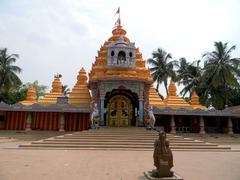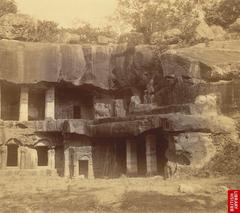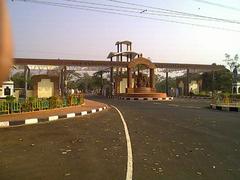Parsurameswara Temple Bhubaneswar: Visiting Hours, Tickets & Historical Sites Guide
Date: 15/06/2025
Introduction
Parsurameswara Temple stands at the heart of Bhubaneswar, Odisha, as one of the most significant and best-preserved monuments of early medieval India. Built around 650 CE during the Shailodbhava dynasty, this sacred site is not only celebrated for its pioneering Kalinga architectural style but also for its unique religious syncretism. The temple’s intricate stone carvings, introduction of the jagamohana (assembly hall), and the earliest depiction of the Saptamatrikas (seven mother goddesses) make it a must-visit for history enthusiasts, art lovers, and spiritual seekers alike (templesofindia.org, orissaguide.com).
This guide provides detailed insights into the temple’s history, architecture, rituals, visitor information, accessibility, travel tips, and nearby attractions—helping you plan a rich and rewarding visit to Bhubaneswar’s temple heritage.
Historical Background and Cultural Significance
Origins and Architectural Context
Parsurameswara Temple is among the earliest extant Hindu temples in Bhubaneswar, tracing its origins to the 7th century CE (templesofindia.org). Built by the Shailodbhava dynasty, it introduced key architectural features that became hallmarks of Odishan temple design, notably the jagamohana (assembly hall) attached to the sanctum (vimana). The temple’s modest yet refined proportions, east-facing entrance, and harmonious structure reflect the maturing Kalinga style, bridging primitive rock-cut shrines and the grand temples that define Bhubaneswar’s skyline (Odisha Tourism).
Artistic and Religious Innovations
Parsurameswara is distinguished by its profusion of stone carvings that narrate mythological stories, daily life, and religious motifs. The northern wall features the earliest known depiction of the Saptamatrikas—Chamunda, Varahi, Indrani, Vaishnavi, Kaumari, Shivani, and Brahmi—underscoring the temple’s inclusive spiritual ethos (The Temple Guru). The temple also displays Shaiva, Shakta, and Vaishnavite iconography, representing a syncretic blend of traditions prevalent in early medieval Odisha.
Rituals, Festivals, and Living Traditions
The temple remains an active center of worship, with daily rituals dedicated to Lord Shiva. Major festivals include Parashurashtami, honoring Parashurama, and Maha Shivaratri, attracting devotees who participate in special ceremonies and night-long vigils (Wikipedia). Visitors can experience the vibrant spiritual atmosphere during these events, complemented by the temple’s tranquil gardens and the nearby sacred Bindu Sagar pond.
Conservation and Heritage
Over the centuries, Parsurameswara Temple has been meticulously maintained, with significant conservation efforts led by the Archaeological Survey of India to preserve its intricate carvings and structural integrity (Odisha Tourism). Informational signage, guided tours, and improved amenities have enhanced the visitor experience, balancing preservation with accessibility.
Visitor Information
Location and Accessibility
- Address: Near Bindu Sagar Pond, Old Town, Bhubaneswar, Odisha, 751002, India (inbhubaneswar.com)
- Getting There:
- Airport: Biju Patnaik International Airport (3.6 km)
- Railway Station: Bhubaneswar Railway Station (3.9 km)
- Bus Stand: Baramunda ISBT (7.3 km)
- Transport: Accessible by taxi, auto-rickshaw, or local buses. Private cabs are recommended for comfort (bhubaneswartourism.in).
Visiting Hours and Entry
- Opening Hours: 5:00 AM – 6:00 PM daily (bhubaneswartourism.in, inbhubaneswar.com)
- Entry Fee: Free for all visitors; donations are welcome (eodisha.in, temple.yatradham.org)
Dress Code and Etiquette
- Dress modestly, covering shoulders and knees.
- Remove footwear before entering temple premises.
- Maintain silence and respect worshippers.
- Photography is generally allowed; avoid flash and heed any posted restrictions (eodisha.in).
Facilities
- Rest areas and shaded gardens within temple grounds (kevinstandagephotography.wordpress.com)
- Public restrooms nearby (basic facilities)
- Eateries and tea stalls in the Old Town area
- Limited parking; public transport recommended during festivals or weekends
What to See and Do
- Marvel at the Architecture: Observe the square vimana, rectangular jagamohana, and terraced roof—hallmarks of early Kalinga style.
- Examine the Sculptures: Discover intricate carvings of the Saptamatrikas, Shiva as Nataraja, Parvati, Ganesha, and mythological scenes (visit.bhubaneswar.me).
- Shivalingas: View the thousand miniature Shivalingas in the northwest quadrant (inbhubaneswar.com).
- Festivals: Experience Parasumastami and Maha Shivaratri, with special rituals and processions.
- Relax in the Gardens: Enjoy the temple’s peaceful gardens and the nearby Bindu Sagar pond (bhubaneswartourism.in).
Accessibility and Safety
- The temple complex is mostly at ground level with uneven surfaces and steps; wheelchair access is limited.
- General safety is good; standard precautions are advised.
- Crowds are manageable except during major festivals, when larger gatherings occur.
Travel Tips
- Visit early in the morning for a peaceful experience and cooler temperatures.
- Wear comfortable footwear (to be left at the entrance).
- Carry water, especially in summer.
- Hire a local guide for deeper insights into the temple’s art and history.
- Combine your visit with other nearby temples for a comprehensive Bhubaneswar heritage tour (tourismorissa.org).
Nearby Attractions
- Lingaraj Temple: The largest and most revered temple in Bhubaneswar (about 1 km away; non-Hindus not permitted inside sanctum).
- Mukteswara Temple: Renowned for its ornate gateway and carvings.
- Rajarani Temple: Noted for unique architecture and erotic sculptures.
- Kedar Gouri and Ananta Vasudeva Temples: Significant for their religious and architectural heritage (inbhubaneswar.com, travelsetu.com).
Accommodation
Options range from budget guesthouses and dharamshalas to mid-range hotels near the temple:
- Hotel Swagat Inn
- Odisha Gujarat Bhavan
- Jain Dharamshala
- Sri Raghavendra Swamy Mutt
- ISKCON Guest House (temple.yatradham.org)
Book ahead during festivals or peak tourist season.
Frequently Asked Questions (FAQs)
Q1: What are the visiting hours of Parsurameswara Temple?
A1: 5:00 AM to 6:00 PM daily.
Q2: Is there an entry fee?
A2: No, entry is free for all.
Q3: Can I take photographs inside the temple?
A3: Photography is generally allowed, but avoid disturbing rituals; check for restrictions at the entrance.
Q4: Is the temple wheelchair accessible?
A4: The temple has uneven surfaces and steps; wheelchair access is limited.
Q5: What is the best time to visit?
A5: October to March, when the weather is pleasant.
Q6: Which other temples are nearby?
A6: Mukteswara, Lingaraj, Rajarani, Kedar Gouri, and Ananta Vasudeva temples.
Emergency Contacts
- Tourism Helpline: 1800 345 0061; Landline 0674 2548295 (visit.bhubaneswar.me)
- Local Police: Available in the Old Town area
Conclusion
Parsurameswara Temple is a singular gem in Bhubaneswar’s architectural and spiritual landscape. Its ancient carvings, syncretic iconography, and living traditions offer a profound window into Odisha’s temple heritage. With easy accessibility, free entry, and proximity to other historical sites, it is ideal for all travelers seeking a blend of history, art, and devotion.
Plan your visit during the cooler months, respect local customs, and consider guided tours to enhance your experience. For more resources, download the Audiala app, follow our social media channels, and explore further posts about Odisha’s remarkable temple culture.
References
- Parsurameswara Temple - Temples of India
- Parsurameswara Temple - Orissa Guide
- Parsurameswara Temple - Wikipedia
- The Temple Guru - Parsurameswara Temple, Bhubaneswar
- Odisha Tourism - Parsurameswara Temple
- Parsurameswara Temple Bhubaneswar - inbhubaneswar.com
- eodisha.in - Parsurameswara Temple Bhubaneswar
- temple.yatradham.org - Parsurameswara Temple
- kevinstandagephotography.wordpress.com - Parsurameswara Temple
- visit.bhubaneswar.me - Parsurameswara Temple
- bhubaneswartourism.in - Parsurameswara Temple
- travelsetu.com - Parsurameswara Temple
- tourismorissa.org - 7 Must Visit Temples in Bhubaneswar








